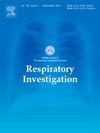Incidence and clinical significance of acute exacerbation of interstitial lung disease in patients with primary Sjögren's syndrome
IF 2.4
Q2 RESPIRATORY SYSTEM
引用次数: 0
Abstract
Background
Acute exacerbation (AE) is defined as acute deterioration in the respiratory status that can lead to a fatal outcome. It may occur in various types of interstitial lung disease (ILD). However, its incidence and clinical picture in patients with primary Sjögren's syndrome-associated interstitial lung disease (pSjS-ILD) remain unclear. Therefore, this study aimed to examine the incidence and clinical significance of AE in patients with pSjS-ILD.
Methods
This study included 101 consecutive patients with pSjS-ILD. The clinical findings at diagnosis, AE development, and outcome were analyzed. Furthermore, the prognostic significance of AE was evaluated via Cox proportional-hazards analysis with time-dependent covariates. The Fine–Gray subdistribution hazard model was employed to identify factors associated with AE development.
Results
Of the 101 patients, 17 (17 %) developed AE during their clinical course. The cumulative incidence rates of AE were 2.0 %, 11.2 %, and 18.1 % at 1, 5, and 10 years, respectively. Multivariate analysis revealed that AE development was significantly associated with poor prognosis (hazard ratio: 3.69; P = 0.01) as well as age, male sex, and %FVC. Moreover, the serum levels of surfactant protein-D at diagnosis were significantly associated with AE development. Of the 17 patients demonstrating AE, 8 died, with a 60-day post-AE mortality rate of 47 %. The age and serum C-reactive protein level at AE onset were significantly associated with 60-day mortality in patients with AE of pSjS-ILD.
Conclusion
AE occurs with a certain frequency and is strongly associated with poor outcome in patients with pSjS-ILD.
原发性Sjögren综合征患者间质性肺病急性加重的发生率及临床意义
背景:急性加重(AE)被定义为可导致致命结果的呼吸状态急性恶化。它可发生在各种类型的间质性肺疾病(ILD)。然而,其在原发性Sjögren综合征相关间质性肺疾病(pSjS-ILD)患者中的发病率和临床表现尚不清楚。因此,本研究旨在探讨AE在pSjS-ILD患者中的发生率及临床意义。方法本研究纳入101例pSjS-ILD患者。分析诊断时的临床表现、AE的发展和结局。此外,通过含时间相关协变量的Cox比例风险分析评估AE的预后意义。采用Fine-Gray亚分布风险模型识别与AE发展相关的因素。结果101例患者中,17例(17%)在临床过程中发生AE。AE的累积发病率在1年、5年和10年分别为2.0%、11.2%和18.1%。多因素分析显示AE的发生与不良预后显著相关(风险比:3.69;P = 0.01)、年龄、男性性别、FVC %。此外,诊断时血清表面活性蛋白d水平与AE的发展有显著相关性。在17例出现AE的患者中,8例死亡,AE后60天死亡率为47%。AE发病时的年龄和血清c反应蛋白水平与AE合并pSjS-ILD患者60天死亡率显著相关。结论ae在pSjS-ILD患者中有一定的发生率,且与预后不良密切相关。
本文章由计算机程序翻译,如有差异,请以英文原文为准。
求助全文
约1分钟内获得全文
求助全文

 求助内容:
求助内容: 应助结果提醒方式:
应助结果提醒方式:


